Glycomics Market Size and Trends
The glycomics market is estimated to be valued at USD 2.26 Bn in 2025 and is expected to reach USD 5.56 Bn by 2032, growing at a compound annual growth rate (CAGR) of 13.7% from 2025 to 2032.
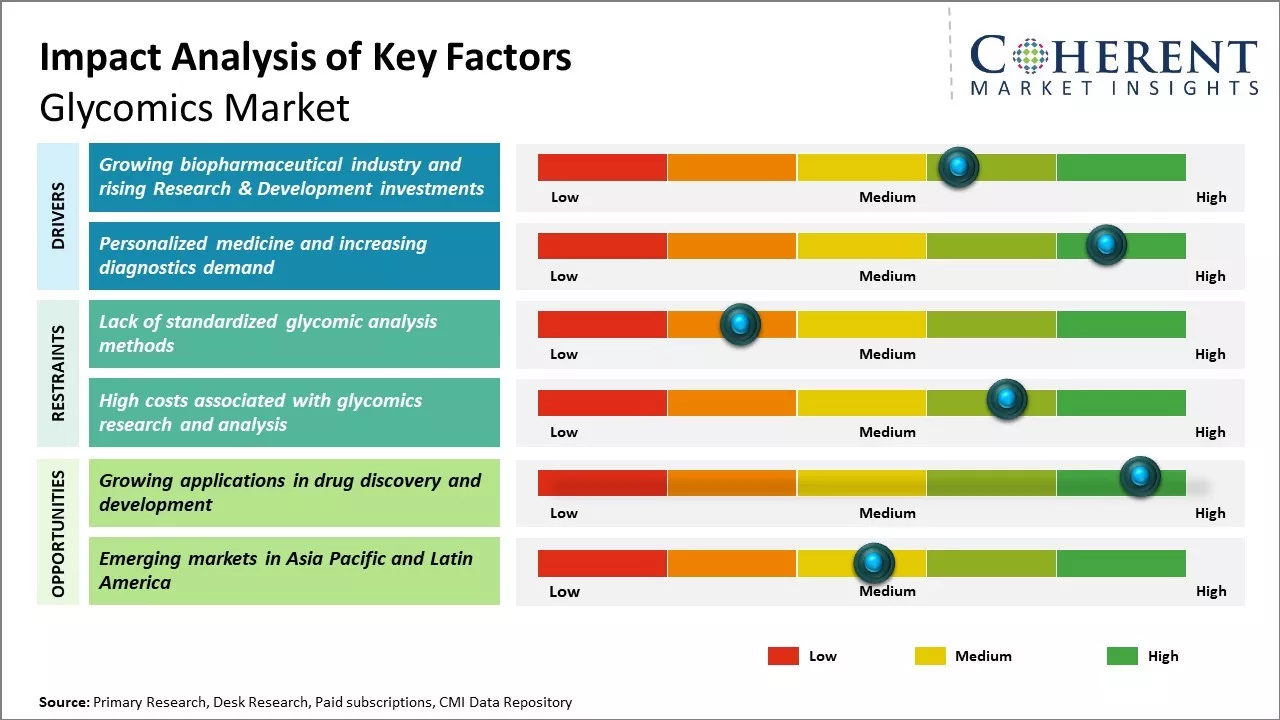
Discover market dynamics shaping the industry: Download Free Sample
The market is witnessing high growth due to increasing research activities in the field of glycomics. Glycomics helps in developing novel drug targets and precision medicine approaches for various diseases such as cancer and diabetes. Various initiatives by governments and private organizations are providing funding for glycomics research which is further supporting the market growth. Rising demand for glycan-based tests and growing application of glycomics in developing vaccines and biomarkers are some of the key factors driving the glycomics market growth.
Growing biopharmaceutical industry and rising research & development investments
The major driver behind the growth of the glycomics market is the rising need for glycomics technologies in drug discovery and development processes by biopharmaceutical companies. Glycans and glycoproteins play vital roles in various biological processes and disease mechanisms. Understanding protein glycosylation is important for developing antibodies, vaccines, and other therapeutic proteins. Over the past few years, there has been significant investments made by leading biopharmaceutical players in setting up glycan analysis facilities and collaborating with glycomics companies. They are using glycomic techniques to aid preclinical and clinical research in areas such as oncology, inflammation, and neurology. The drug development success rate has remained low for years, driving biopharma firms to bank on strategic innovations that can aid target identification and validation. Exploring glycobiology is seen as a promising approach, and this is reflected in the trend of rising R&D allocation towards applying glycomic tools and services.
Market Concentration and Competitive Landscape
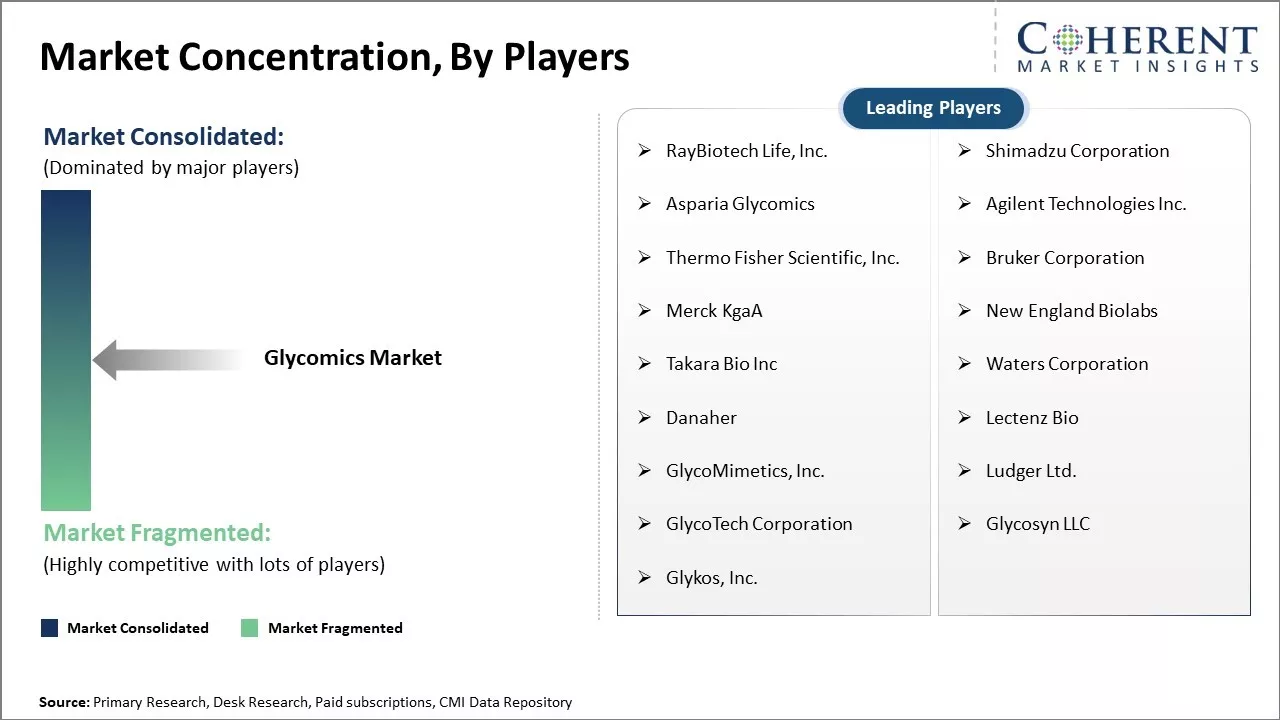
Get actionable strategies to beat competition: Download Free Sample
Personalized medicine and increasing diagnostics demandAnother major factor augmenting the glycomics market growth is the increasing demand for personalized healthcare and precision medicine-driven diagnostic solutions. Analysis of protein glycosylation patterns is garnering significance in disease biomarker discovery for various conditions including cancers. Glycans can serve as biomarkers indicative of specific disease subtypes or stages and patient response to therapies. Glycomic profiling is being extensively researched for clinical applications such as early disease detection, real-time health monitoring, predictive/prognostic testing, and treatment selection. Some key areas where glycans hold diagnostic potential include oncology, infectious diseases, autoimmune disorders, and metabolic diseases. This aligns well with the burgeoning trends of stratified medicine, companion diagnostics, and self-monitoring diagnostics. Glycoprofiling is anticipated to evolve into a vital tool supporting the shift towards customized and selective treatment approaches.
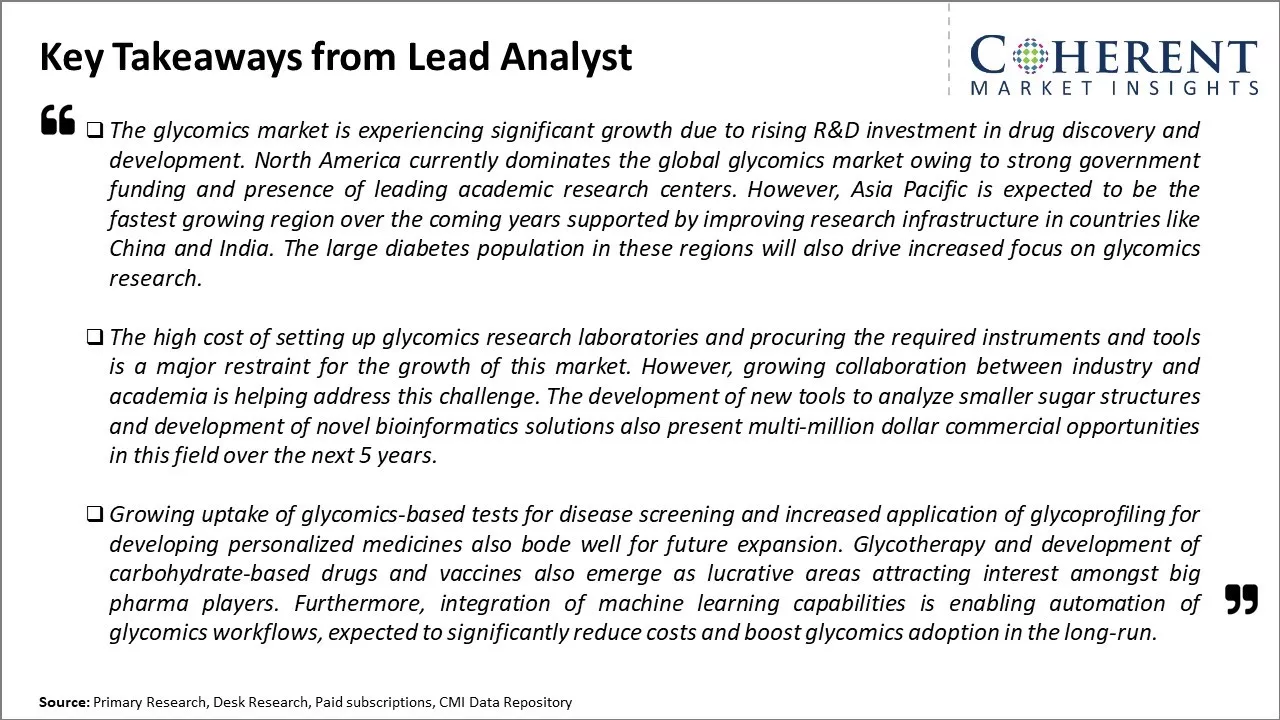
To learn more about this report, Download Free Sample
Market Challenges: Lack of standardized glycomic analysis methodsThe glycomics market faces several challenges. The glycan structures are extremely complex and variable, making analysis difficult. Sample collection and processing can also be challenging due to issues like low abundance and degradation. There is a lack of standardized glycomic analysis methods and technologies, making comparability between studies problematic. Glycomic analyses typically require specialized, expensive instruments, and technicians with relevant expertise, limiting access.
Market Opportunities: Growing applications in drug discovery and development
The capability to examine glycans holds the potential to offer understandings into diverse health conditions and identify novel targets for drug development. Personalized medicine approaches relying on glycans could enable more precise disease diagnoses and treatments. Glycomics applications in developing vaccines, cancer biomarkers, and other therapeutic areas are creating lucrative opportunities for market development Additionally, technological advancements are gradually reducing costs and complexity, making comprehensive glycomic analysis more feasible.
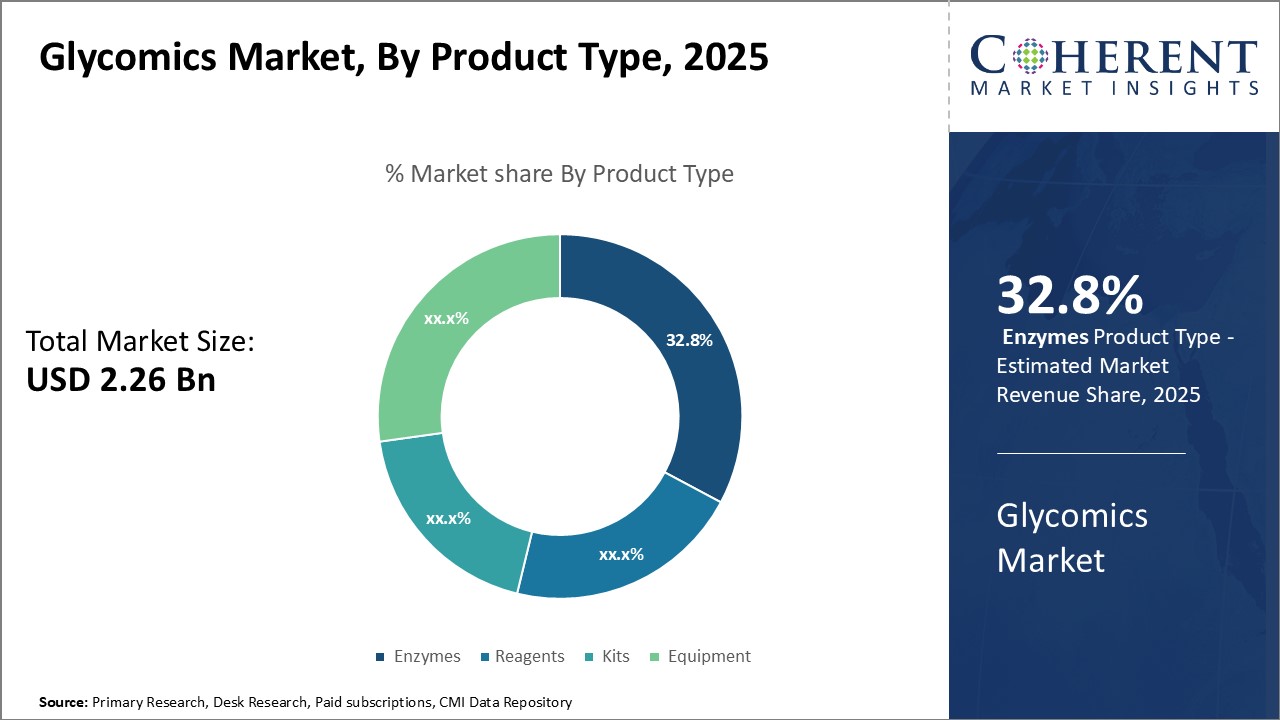
Discover high revenue pocket segments and roadmap to it: Download Free Sample
Insights, By Product Type: Enzymes remain the standard for glycomics research due to their unique advantagesThe product type segment includes reagents, enzymes, kits, and equipment. Enzymes segment is anticipated to hold 32.8% of the market share in 2025. Glycomics research often requires specificity and precision to elucidate complex glycoprotein structures. Enzymes offer unmatched selectivity and consistent activity levels that allow researchers to reliably catalyze desired glycan remodeling and analysis reactions. Their high catalytic efficiency enables accurate structural readouts even from minute glycoprotein samples. Compared to other products like reagents which may lack selectivity, enzymes precisely cleave or modify glycans of interest without disturbing neighboring linkages. This targeted approach is crucial in glycomics as many glycoproteins contain heterogeneous, branched glycans. The self-contained enzymatic activity of purified preparations also provides reproducible results without additional factors that could compromise specificity. Such consistency and finer control are increasingly important as glycomics tools are asked to characterize novel glycoprotein classes and changes implicated in various diseases. Due to their tightly regulated synthetic mechanisms, enzymes may also be less subject to variability between test batches compared to some kits and reagents. Overall, enzymes remain the gold standard platform for driving core glycomic techniques due to their unmatched selectivity and precision.
Insights, By Application: Drug discovery & development leverages glycomics to expand therapeutic pipelines
The application segment includes diagnostics, drug discovery & development, and others. Drug discovery & development contributed the highest share of the glycomics market and is projected to hold 45.6% of the market share in 2024. Glycans modulate properties like stability, absorption, and immune recognition that are critical to a drug's efficacy and safety. Characterizing 'glycosignatures' associated with disease states can also reveal protein biomarkers and drug targets. Glycomics is leveraged from target identification to lead optimization. Cell line engineering uses glycomic data to produce biologics with customized glycoforms tailored for specific indications. Analytical skills further assist in comparing biosimilars to reference products. As biologics pipelines expand, glycomics is increasingly employed to engineer next-generation formats like antibody-drug conjugates. It also investigates immune responses to therapies to understand adverse reactions. The complex interplay between glycans and protein pharmacology demands additional glycomic insights. As new precision therapies emerge, glycomics will remain indispensable for modulating biologics for optimal therapeutic windows.
Insights, By End User: Increase in research & development activities by biopharmaceutical companies
The end user segment includes biopharmaceutical companies, academic & research institutes, CROs, and others. Biopharmaceutical companies contributed the highest share of the glycomics market and is projected to hold 49.8% of the market share in 2025. Biopharmaceutical companies develop their own drugs and biologics and have the largest R&D budgets and regulatory obligations. They spearhead incorporating glycomics into core workflows to gain strategic advantages. Deeper characterization of experimental biologics aids in selection and engineering of clinical candidates. Targeted analytical support then tracks glycosylation consistency through manufacturing and stability studies as required by regulators. Some biopharmaceutical companies also develop custom glycomic services to serve specific pipeline needs like viral vector glycosylation analysis or ADC glycan site mapping. This vertical integration allows real-time glycomic feedback into biologics pipelines. It helps overcome knowledge gaps from relying solely on academic collaborations and Contract Research Organization/vendor partnerships. Additionally, proprietary control of glycomic methods and data protects sensitive findings on pipelines. Some larger biopharmaceutical companies even develop glycoprotein/glycan therapeutics in-house requiring extensive glycomics infrastructure. Thus, biopharmaceutical companies proactively leverage glycomics insights to bolster substantial biologics portfolios.
Regional Insights
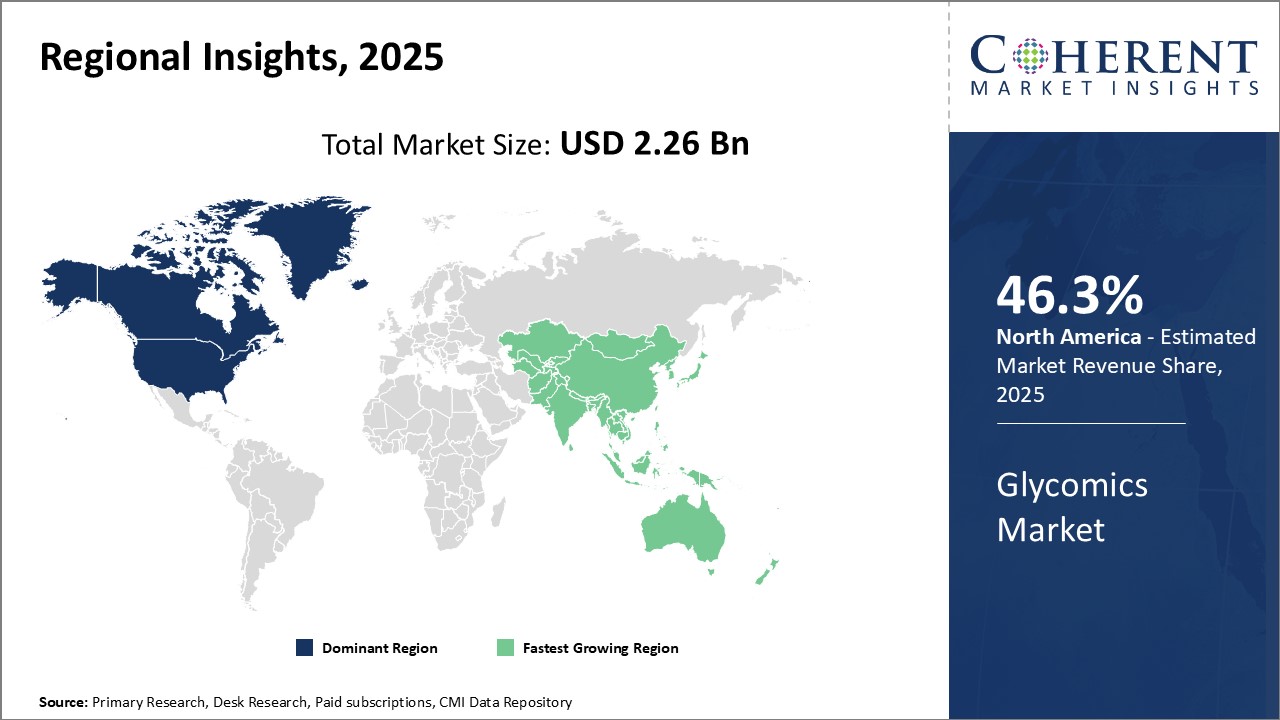
Need a Different Region or Segment? Download Free Sample
North America has established itself as the dominant region in the global glycomics market and is anticipated to hold 46.3% of the market share in 2025. The U.S is one of the major market drivers due to significant investments in R&D activities by both public and private entities. Research funding from federal agencies such as National Institutes of Health (NIH) has propelled glycomics research, resulting in numerous innovative solutions. Additionally, collaboration between industry and academia has strengthened the overall research landscape. Regional firms are well-recognized globally for their expertise in developing novel enzymes, tools and assays that facilitate glycan analysis. This has enabled North America to be at the forefront in clinical applications of glycomics technologies.
Asia Pacific, on the other hand, has emerged as the fastest growing regional market worldwide. Countries, such as China, Japan and South Korea, have demonstrated high potential, especially in the biopharmaceutical manufacturing sector. The presence of established contract manufacturing organizations and lower operating costs have attracted pharmaceutical giants to set up manufacturing bases. This augurs well for glycomics as biologics development depends heavily on glycan analytics. Governments are proactively supporting life sciences by initiating favorable policies and research incentives. China, in particular, has poured billions of dollars in the last decade to develop its domestic capability across the MedTech, pharmaceutical, and healthcare sectors. Many regional firms have gained global reputation for providing high-quality bioanalytics services at competitive prices. Their capabilities around assay development, glycan sequencing, and expression analysis continue to expand. With economic growth accelerating research investments, Asia Pacific is clearly the next hotspot for glycomics opportunities.
Market Report Scope
Glycomics Market Report Coverage
| Report Coverage | Details | ||
|---|---|---|---|
| Base Year: | 2024 | Market Size in 2025: | USD 2.26 Bn |
| Historical Data for: | 2020 To 2024 | Forecast Period: | 2025 To 2032 |
| Forecast Period 2025 to 2032 CAGR: | 13.7% | 2032 Value Projection: | USD 5.56 Bn |
| Geographies covered: |
|
||
| Segments covered: |
|
||
| Companies covered: |
RayBiotech Life, Inc., Shimadzu Corporation, Asparia Glycomics, Agilent Technologies Inc., Thermo Fisher Scientific, Inc., Bruker Corporation, Merck KgaA, New England Biolabs, Takara Bio Inc, Waters Corporation, Danaher, Lectenz Bio, GlycoMimetics, Inc., Ludger Ltd., GlycoTech Corporation, Glycosyn LLC, Glykos, Inc., and Glanbia PLC |
||
| Growth Drivers: |
|
||
| Restraints & Challenges: |
|
||
Uncover macros and micros vetted on 75+ parameters: Get instant access to report
Market Segmentation
- Product Type Insights (Revenue, USD BN, 2020 - 2032)
- Reagents
- Enzymes
- Kits
- Equipment
- Application Insights (Revenue, USD BN, 2020 - 2032)
- Diagnostics
- Drug Discovery & Development
- Others
- End User Insights (Revenue, USD BN, 2020 - 2032)
- Biopharmaceutical Companies
- Academic & Research Institutes
- CROs
- Others
- Regional Insights (Revenue, USD BN, 2020 - 2032)
- North America
- U.S.
- Canada
- Latin America
- Brazil
- Argentina
- Mexico
- Rest of Latin America
- Europe
- Germany
- U.K.
- Spain
- France
- Italy
- Russia
- Rest of Europe
- Asia Pacific
- China
- India
- Japan
- Australia
- South Korea
- ASEAN
- Rest of Asia Pacific
- Middle East
- GCC Countries
- Israel
- Rest of Middle East
- Africa
- South Africa
- North Africa
- Central Africa
- North America
- Key Players Insights
- RayBiotech Life, Inc.
- Shimadzu Corporation
- Asparia Glycomics
- Agilent Technologies Inc.
- Thermo Fisher Scientific, Inc.
- Bruker Corporation
- Merck KgaA
- New England Biolabs
- Takara Bio Inc
- Waters Corporation
- Danaher
- Lectenz Bio
- GlycoMimetics, Inc.
- Ludger Ltd.
- GlycoTech Corporation
- Glycosyn LLC
- Glykos, Inc.
- Glanbia PLC
Share
Share
About Author
Abhijeet Kale is a results-driven management consultant with five years of specialized experience in the biotech and clinical diagnostics sectors. With a strong background in scientific research and business strategy, Abhijeet helps organizations identify potential revenue pockets, and in turn helping clients with market entry strategies. He assists clients in developing robust strategies for navigating FDA and EMA requirements.
Missing comfort of reading report in your local language? Find your preferred language :
Transform your Strategy with Exclusive Trending Reports :
Frequently Asked Questions
EXISTING CLIENTELE
Joining thousands of companies around the world committed to making the Excellent Business Solutions.
View All Our Clients
